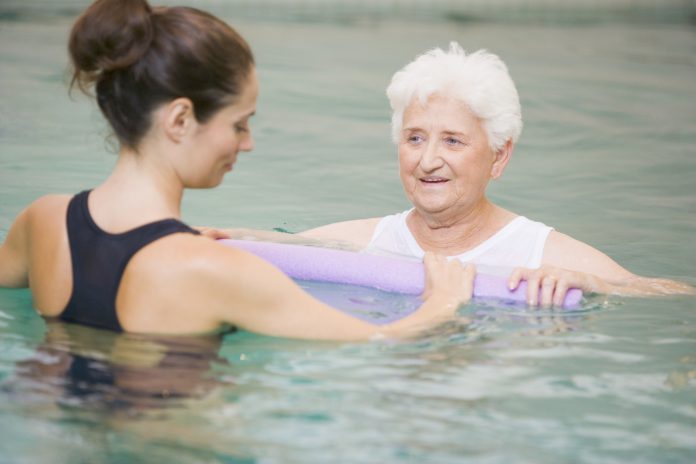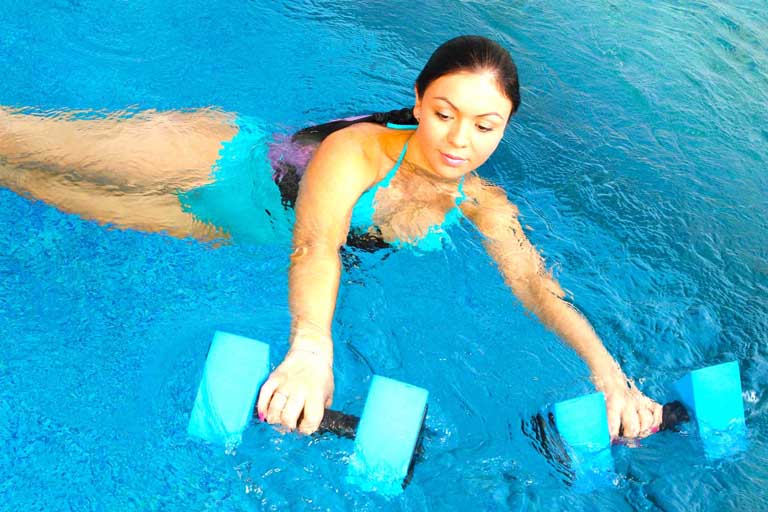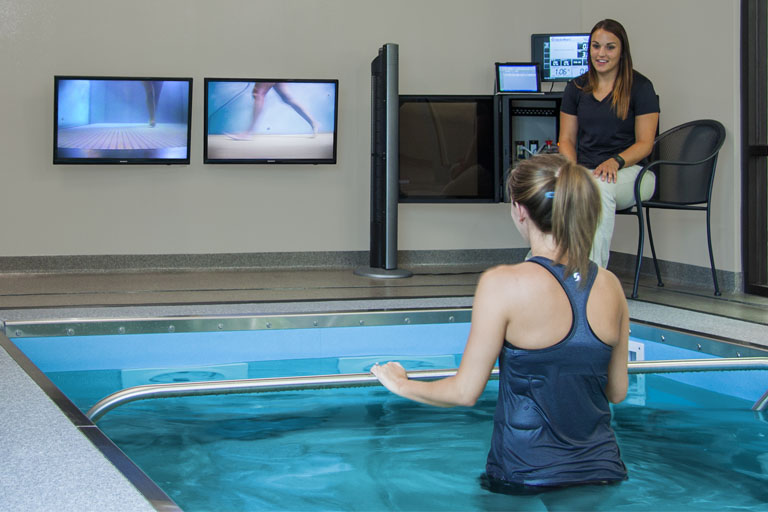
Water therapy, also known as aquatic therapy, aquatic rehabilitation, therapeutic aqua exercise, pool therapy or hydrotherapy, is becoming a popular alternative to traditional therapy methods because of its ability to be safer for all ages and fitness levels. Participating in this type of activity includes any exercises or therapy done partly submerged in water, usually in a pool, but it could be any other type of aquatic environment. What makes hydrotherapy different from utilizing water settings for regular exercising is that it incorporates a trained professional supervising the experience and is recommended as a treatment to a patient. An insurance provider also most likely covers the therapy. Aquatic exercise is usually done in groups, though not always, and wouldn’t be covered by insurance or necessarily supervised by a professional.
Why Do Aquatic Therapy?

Doing exercises in a pool versus on land provides a lot of benefits. The way water supports body weight creates an environment that is easier to move in and improves flexibility. Water also strengthens muscles by providing resistance to the exercise movements. The water’s buoyancy decreases any stress on joints that may otherwise inhibit the body’s ability to complete the exercise safely and consistently. The pressure of the water supports the body and provides the perfect workout environment. Water’s properties make it easy for people seeking treatment to safely heal, while also granting quicker recovery times and boosted levels of fitness. Hydrotherapy strives to assist patients with movement; enhance aerobic capacity; improve balance, coordination and flexibility; and build muscle endurance and strength all while encouraging relaxation and reducing stress.
Pool Prep

Before jumping into the pool for therapy, you will need to get your doctor’s opinion on whether water therapy is for you. After you receive the OK, you will choose or be assigned a hydrotherapy professional to work with. Even though you’ll be surrounded by water, be sure to drink plenty before beginning your exercises. You won’t realize you’re sweating even if you are. Other ways to prepare for the water is to purchase water shoes for traction, noodles or other flotation devices to utilize in deeper water, webbed gloves, kickboards and weights. When working with a professional, however, these items will most likely be supplied to you.
7 Simple Aquatic Exercises and Benefits
Now that you understand what water therapy is, its benefits as a whole and how to prepare yourself for the experience, take a look at these seven exercises and the areas of the body they specifically benefit. Remember, to participate in hydrotherapy, you would be working with a trained professional. Listening to this professional comes before incorporating anything you’ve learned elsewhere. Your supervisor will be up-to-date on your specific needs and know best how to help you. Taking that into consideration, the following are simple exercises to help build endurance, muscle and strength during your recovery process.
1. Planks
Take a pool noodle and hold it out in front. As you lean forward into the noodle, keep your elbows pointing downward, and your body will take on a plank position with the noodle submerged underwater. Hold this formation as long as you can or for 30-60 seconds, whichever comes first.
By doing a plank, you are strengthening your core by engaging your abdomen, obliques and spine, but it is a whole body exercise and will translate into other areas of your workout, giving you a greater benefit overall.
2. Walking, Jogging or Running
This exercise can be done on your own without any equipment, or you may want to utilize an underwater treadmill. When doing it manually, take your place in the pool at waist- or chest-leveled water. You can just walk forward or alternate walking 15 steps forward followed by 15 steps backward, or whatever number you choose. To increase difficulty, increase your speed. You can alternate with jogging to increase the intensity even more. Do this exercise for about five minutes.
Using an underwater treadmill, if you have one available to you, is also a great option. Underwater running is similar to running on land in both form and cardiovascular benefits. Running in water, however, forces your muscles to do more work than if you were running through the air. This gives you a solid workout without having to run as far or as fast as you normally would by running outside. Wear minimal clothing that’s fitted, such as spandex or even regular swimwear, and you can choose to run in shoes or barefoot.
3. Cycling
Cycling underwater is another form of exercise that can be done either manually or with equipment. If you choose to do this exercise manually, move to deeper water. Take one or two pool noodles and place them behind you so you’re able to lean back against them, resting your arms on the top of the noodle for extra support. Once in position, move your legs as you would if you were on a bike. Do this exercise for five minutes. If you use equipment, the exercise is almost just like being on a stationary bike except you’re in the water.
Cycling decreases body fat and helps to increase endurance and strength. This exercise mostly utilizes your legs, but if on a stationary bike, you’re also using your upper body to stabilize yourself, working your back, biceps, chest, shoulders and triceps.
4. Push-ups
There are two push-up variations to do in a pool, and they start the same way. The easier variation is to stand facing the side of the pool. Lean forward to reach out your hands to place them on the edge of the pool so your arms are shoulder-width apart. Lean your chest and press weight through your arms down to your hands to activate the push-up. Repeat 15 or more times.
The second variation starts the same, by standing and facing the side of the pool, but this time a little closer. Place your hands on the edge so your arms are shoulder-width apart. Raise your body up and out of the pool by pressing weight through your arms down to your hands while keeping your elbows bent slightly. Hold your body in this position, halfway out of the water, for three seconds before lowering yourself back down slowly. Repeat 10 times or until you’re fatigued.
Utilizing your abdominal muscles, deltoids, pectoral muscles and triceps, push-ups are great for strengthening your chest and shoulders. These two variations, though a little different, will produce similar results.
5. Leg Raises
If you have good balance, you can do this anywhere in the pool and place your hands on your hips for the exercise. If you need extra help, however, stand near a side to grab the edge for support. The movement starts with the standing leg slightly bent and the other leg outstretched in front of you. One rep will be moving the outstretched leg down to the standing position without putting weight on the leg and back up again. Repeat this exercise with raising the leg to the side, as well as lifting the leg back before turning around and repeating on the other side of your body. Through this exercise, your lower back, hips and legs will be stretched and strengthened. Repeat this entire circuit 10 times.
6. Lunges
Lunges in the water are the exact same as lunges on land. If necessary, stand by a pool wall for extra support. Take a large step in the direction you wish to start without letting the forward knee go past your toes. Return back to standing and start again with the next direction, moving forward, to your side and back. Make sure to hit all directions, going in the shape of a clock if it’s easier for you to visualize. Hit all directions 10 times.
Lunges engage muscles used in a lot of day-to-day situations. When you incorporate more directions, you’re working even more muscles, including the abdomen, back, butt, calves, hamstrings, hips, inner thighs and quadriceps.
7. Arm Circles
There are two variations of arms circles that can be done in the pool. The first one is to stand in deeper water where your arms and shoulders are completely covered but you’re still able to stand flat on your feet. Extend your arms straight out from your body so you take the shape of a “T.” Begin to circle your arms, big and small, but remember to keep your arms below the water’s surface.
The next variation is to float on your back, which may add a level of difficulty, so only attempt if you’re comfortable. Instead of a full circle, you’ll be attempting a semicircle. While floating on your back, slowly and gently move your arms from straight at your sides to straight above your head, keeping them just below the surface of the water for the entire movement. Place a noodle or two under your back if you need extra support. Do both variations for 30-60 seconds or until fatigued.
Arm circles benefit and target your back, biceps, triceps and shoulders. This type of exercise is known as a dynamic stretch, which means that you stretch while you move, increasing circulation to your shoulders, fingers and arms. If you’d like to add a level of difficulty to each variation of this exercise, you can use light hand weights or webbed gloves.



